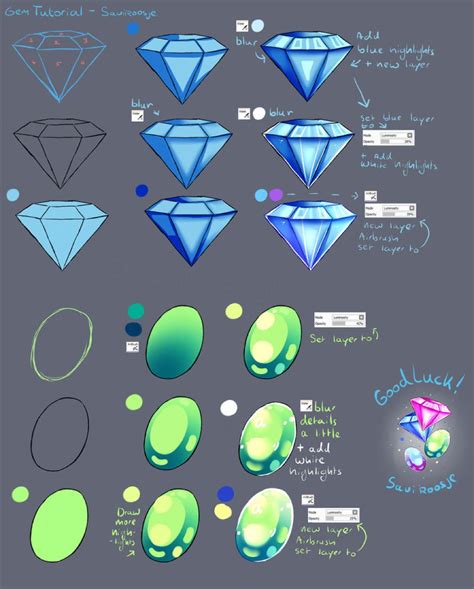How To Paint A Gem
Ronan Farrow
Mar 19, 2025 · 4 min read

Table of Contents
How to Paint a Gem: A Step-by-Step Guide for Beginners and Beyond
Want to learn how to paint realistic and captivating gems? Whether you're a seasoned artist or just starting, this guide will equip you with the techniques and knowledge to bring the sparkle and brilliance of gemstones to your canvas. We'll cover everything from choosing the right paints and brushes to mastering the art of highlighting and shadowing for a truly dazzling effect.
Choosing Your Medium and Materials
The beauty of painting gems lies in your ability to capture light and depth. Acrylics, watercolors, and oils each offer unique possibilities.
Acrylics: The Versatile Choice
Acrylic paints offer a great balance of vibrancy, quick drying time, and easy cleanup. They're a fantastic choice for beginners and allow for layering and blending techniques essential for capturing gem depth.
Watercolors: A Transparent Delight
Watercolors, with their translucent quality, are perfect for creating a luminous effect, ideal for capturing the inner glow often found in gemstones. However, achieving strong highlights might require more layers.
Oils: The Master's Medium
Oil paints provide the richest colors and the most control over blending, making them a favorite among professional artists. However, they require more patience due to their slower drying time.
Essential Materials:
- Paints: Choose a range of colors appropriate for the gem you're painting. For example, painting an emerald will require greens, yellows, and blues.
- Brushes: Invest in a variety of brushes – synthetic for acrylics and watercolors, and natural hair for oils – in different sizes for fine detail and broader strokes. Round brushes are excellent for detailing, while flat brushes are useful for laying down base colors.
- Palette: A palette, whether disposable or reusable, helps in mixing colors.
- Canvas or Paper: Choose a high-quality surface that can handle your chosen paint. Smooth surfaces work best for capturing detail in gems.
- Water Container and Rags/Paper Towels: Essential for cleaning your brushes and controlling paint consistency.
Mastering the Techniques: From Base to Brilliance
Painting gems isn't about simply filling in color. It's about mimicking the way light interacts with the gem's facets and surfaces.
1. Laying the Foundation: The Base Coat
Begin with a smooth, even base coat of the gem's primary color. This provides a foundation for subsequent layers and enhances the overall luminosity. Allow the base coat to dry completely before proceeding.
2. Building Depth: Shadows and Highlights
Gems exhibit dramatic shifts in tone due to the way light reflects off their surfaces. Use darker shades to create shadows in crevices and areas where light doesn't reach directly. Conversely, use lighter shades, possibly even white, to create brilliant highlights where light hits most intensely.
3. Adding Dimension: Layering and Blending
Layering colors strategically helps in building dimension. Use thin layers, allowing each layer to dry before applying the next one. This prevents muddiness and enhances depth and clarity. Blending colors smoothly transitions between shadow and highlight, further enhancing realism.
4. Capturing the Sparkle: Glazing and Detailing
To create the characteristic sparkle of a gem, consider using glazing techniques. Glazing involves applying thin, transparent layers of color that subtly alter the tone and luminosity, giving your gem painting incredible depth. This is particularly useful in capturing the inner glow effect found in many gemstones.
Fine details are key to achieving realism. Use fine brushes to paint precise lines and facets, meticulously replicating the gem's structure.
5. The Finishing Touches: Refinement and Detail
Take your time to refine the painting, paying attention to every detail. Assess the light and shadow interactions carefully. Are the highlights bright enough? Are the shadows deep enough? Adjust as needed until you achieve the desired effect.
Beyond the Basics: Exploring Different Gem Types
Different gemstones possess unique characteristics in terms of color, translucency, and structure.
Painting Specific Gemstones
- Emeralds: Focus on rich greens, with hints of yellow and blue. The internal structure of emeralds often displays a slightly clouded effect that adds to their allure.
- Rubies: Create a deep red base, with flashes of crimson and orange in the highlights. Rubies sometimes exhibit a star-like effect.
- Sapphires: Sapphires come in various colors, but the most popular is blue. Build depth through various shades of blue, adding hints of purple or green depending on the specific shade you're aiming for.
- Diamonds: Diamonds are notoriously challenging. Focus on intense highlights and subtle shadows to convey the clarity and brilliance of the stone. Consider adding small, sparkling details to capture the diamond’s famous sparkle.
By following these steps and practicing regularly, you'll be amazed at the stunning gem paintings you can create. Remember, patience and practice are key to mastering the art of capturing light and brilliance on your canvas. Happy painting!
Featured Posts
Also read the following articles
| Article Title | Date |
|---|---|
| How To Sell Used Firearms | Mar 19, 2025 |
| How To Replace Shift Linkage Bushings | Mar 19, 2025 |
| How To Make Liposomal Vitamin C | Mar 19, 2025 |
| How To Remove Bolts From Concrete | Mar 19, 2025 |
| How To Read Music Notes For Trumpet | Mar 19, 2025 |
Latest Posts
Thank you for visiting our website which covers about How To Paint A Gem . We hope the information provided has been useful to you. Feel free to contact us if you have any questions or need further assistance. See you next time and don't miss to bookmark.
